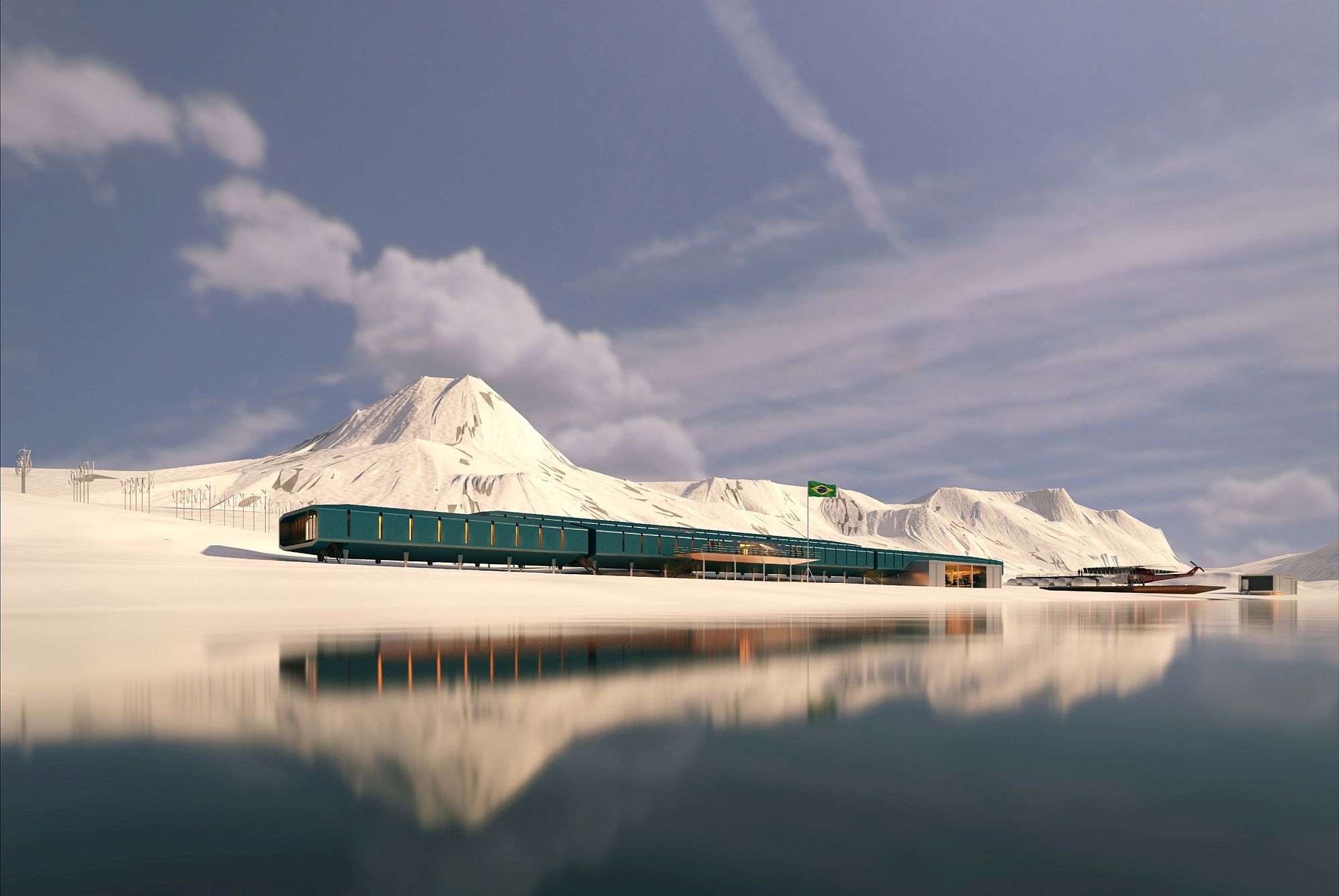The Brazilian Navy (MB, in Portuguese) confirmed the March 2019 completion of the new Comandante Ferraz Antarctic Station (EACF, in Portuguese). MB estimates that EACF will be in full operation by March 2020. Currently, 263 workers from the construction company are on King George Island, in the Keller Peninsula, fine-tuning the structure.
Workers are finalizing the assembly of three blocks that make up the main building (eastern, western, and technical). In addition to researchers, the building will host 16 MB service members who will be part of the core group stationed on the continent. The eastern block has 14 laboratories, cafeterias, kitchens, a health department, drying room, and shops.
The upper level of the western block will have 32 cabins, a library, gymnasium, and video/auditorium room, and the lower level will have a warehouse for supplies, and water and firefighting tanks. The garage and the engine room are in the station’s technical block. The generators, electric boards, heaters, water and sewage treatment station, and incinerator, among others, will also share that space.
The isolated telecommunications, weather/ozone, ultra-low frequency, sediment cleanup, diving, and hazardous materials units are in the final stage of completion. According to retired MB Captain Geraldo Gondim Juaçaba Filho, a special advisor on EACF reconstruction, six inspectors supervise the work, four being MB naval engineers and the other two from the Brazilian Institute of Environment and Renewable Natural Resources.
The new EACF will offer comfort and safety during the arctic summer and winter, Capt. Geraldo said. “This is the beginning of a new era for research in Antarctica, with equipped laboratories and high-quality telecommunications, which will enable researchers to send data and communicate with their laboratories in Brazil,” he said.
The reactivation of the new EACF has geopolitical relevance for Brazil and MB. The country has been a signatory member of the Antarctic Treaty since 1975, securing participation in discussions about the future of the continent, which has the largest freshwater reserve on the planet. The treaty states that countries may only conduct scientific explorations in Antarctica under an international cooperation system.
A fire completely destroyed the Brazilian station in Antarctica in 2012. The reconstruction work only started in early 2016. The distance, logistics, and climate challenges affected the duration of the project.
“The adverse climate and the fact that work can only be done during the Antarctic summer – between November and March – the distance that separates the worksite from the Antarctic, and an approximate 45-day voyage were challenges that had to be overcome,” Capt. Geraldo said.
“In addition to the complexity of the project, the crews that worked on the reconstruction speak different languages, and have different cultures and customs.”
Despite the challenges, the officer highlighted lessons learned during construction. “We developed construction techniques, from building foundations in rocky and icy soil, to assembling the structure, containers, and overlay. Electric, hydraulic, automation, and other systems were developed specifically for this project,” Capt. Geraldo added.
Logistics Support
The oceanographic support vessel Ary Rongel, responsible for replenishing EACF, and the patrol vessel Almirante Maximiano, which contributes to research in various locations in the Antarctic – including during the voyage from Brazil to the icy continent – provided the logistics support to the Brazilian station.
During winter, when the ship must return to Brazil due to the ocean becoming frozen, replenishment responsibility falls to the Brazilian Air Force (FAB, in Portuguese). The First Transportation Group’s First Squadron (1º/1º GT, in Portuguese) has provided logistics support to EACF for 35 years.
“Aerial resupply missions require a very skilled crew, due to weather restrictions in the Antarctic winter, such as strong winds in the area and the dimensions available in the launching zone,” said FAB Lieutenant Colonel Claudio Rogerio Garcia, commander of 1º/1º GT.
In addition to aerial resupply, the squadron also conducts logistics support missions during the summer, and transports personnel and material from the Brazilian Antarctic Program throughout the year.
MB schedules an average of 10 missions during the Antarctic year, between November and October of the following year. “After the fire, we intensified the trips. At first, the purpose was to demobilize service members and researchers from the station and, subsequently, to provide logistics support to rebuild the structure,” said Lt. Col. Cláudio Garcia.
The officer pointed to the challenging flight over Antarctica for the squadron crew. Experienced instructors, with aviation knowledge in the region always conduct the missions.
“The weather pattern, with strong winds and extremely low temperatures, changes operation parameters of the airplane and requires that all performance charts in the C-130 [airplane] manual be carefully observed to maintain flight safety,” he said.
The gravel runway used in Antarctica – very narrow and worsened by strong cross-winds and the icy weather – is yet another landing challenge. “There is a specific point for aircraft touchdown, which requires a high level of precision, caution, and training from the crew,” Lt. Col. Cláudio Garcia said.
The 1º/1º GT, also known as Gordo Squadron, is headquartered in Rio de Janeiro and has been in operation for 54 years. The aerial unit that conducts support missions for the Antarctic program, logistics air transportation, in-flight refueling, as well as search-and-rescue missions, troop transportation, and in-flight firefighting will receive a new freighter from FAB, the KC-390.
“The squadron is very optimistic with the arrival of the new airplane,” said Lt. Col. Cláudio Garcia. “The new freighter will carry out the unit’s missions, especially in Antarctica, just as the C-130 did for the last 35 years.”
This article appeared originally in Diálogo – https://dialogo-americas.com/en/home






